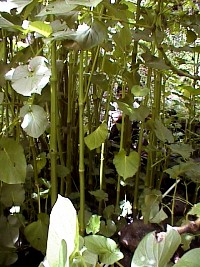
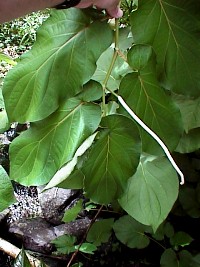
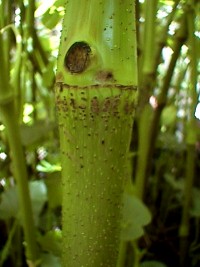
DISCLAIMER Piper auritum is not "Hawaiian Sakau" This was an unfortunate misnomer. It was the original mistaken identification of this plant, hence the name of this file. "Hawaiian sakau", in as much as there is any such plant, is the same as Polynesian sakau, or kava, Piper methysticum.
The following are images of Piper auritum. This plant is NOT Piper methysticum (kava kava or sakau). Where Piper methysticum forms non-spreading clumps, this new plant spreads rapidly via suckers. Piper auritum is a dangerous invasive on Pohnpei. If sighted, please contact either Plant Protection Micronesia, the Conservation Society of Pohnpei, or you can contact the author of this page, Dana Lee Ling.
The first set of images were taken by Dana Lee Ling on 05 February 2000 in Rohi, U. Pedrus Primo assisted with obtaining permission for the images. Images are 24 bit JPEG, please set your screen color depth appropriately. Page was laid out at 800 by 600 resolution, it will look funny at 640 by 480. This page is an estimated 254 second load at 28.8 kbps.



The Piper auritum is growing in a stream, in running water, amongst basalt rocks, in Rohi, U. Above are images of the plant growing out of the stream. Note the "singularity" of the stems: this plant does not form P. methysticum type clumps. A branch and node are seen above.
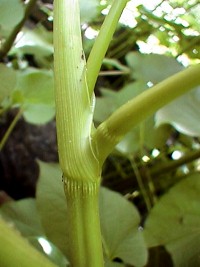
A younger node is seem above with a leaf pedicel.
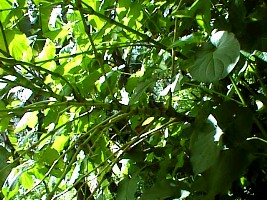
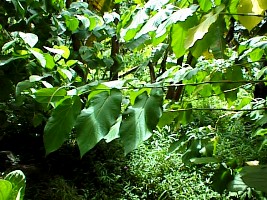
The upper branches on the mature plant extend out horizontally as seen above. The plant grows significantly larger than P. methysticum.
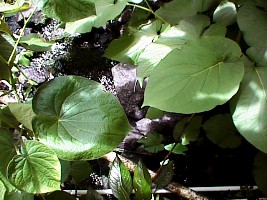
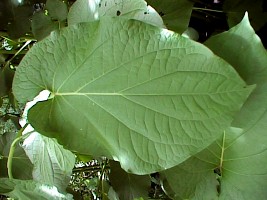
The leaf at the left in the left image above is P. methysticum, immediately to its right is the new plant. The two are growing next to each other at this location. Note the color difference: it is real. A better look at the P. auritum leaf is seen in the image on the above right.
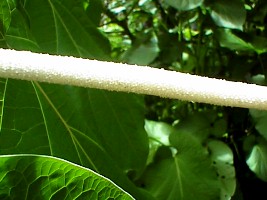
The inflorescence of P. auritum is seen above.
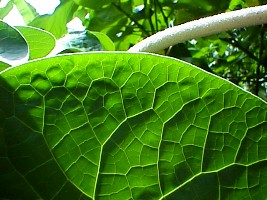
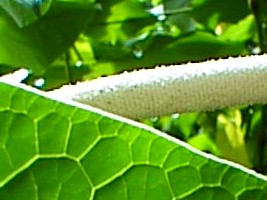
If you hold the leaves up to the sun, you can perceive with your eye a very small, white fringe of hairs on the leaf. The white "rim" on the margins above is real and not a photographic effect. The leaves do have a "medicinal" smell when crushed. Note the inflorescence: that is the most detail I could capture with my equipment. In the field the inflorescence gives the impression of the having the surface of the file.
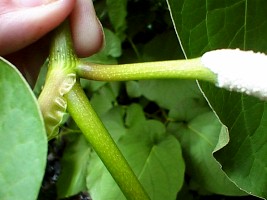
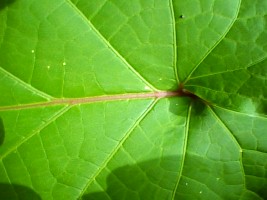
Above is a pedicel. In the venation image note the red tint to the main vein, this is not seen in all P. auritum leaves. It might be related to sun exposure.
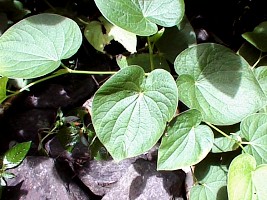
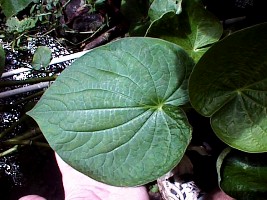
Above, for reference, are images of P. methysticum leaves and branches. See also P. methysticum.
These following images were provided by Mark using photographic equipment provided by the Nature Conservancy office here on Pohnpei. Support for acquiring these images came from COM-FSM Cooperative Extension Service (Land Grant Program) as well as from the Nature Conservancy.
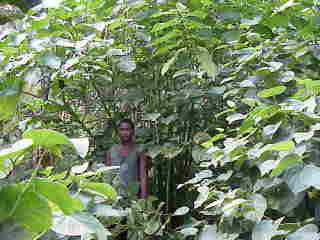
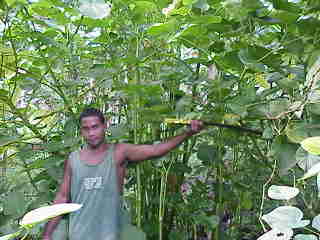
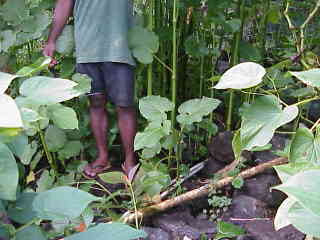
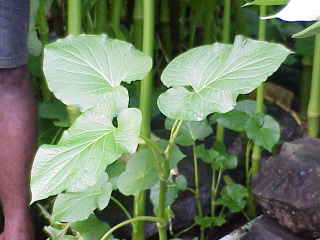
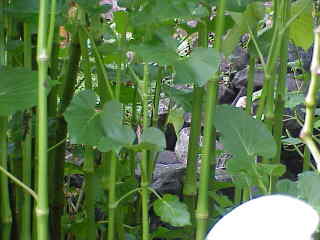
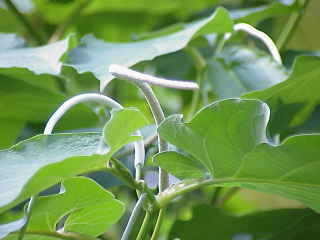
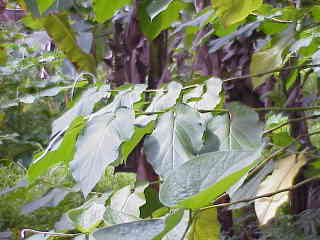
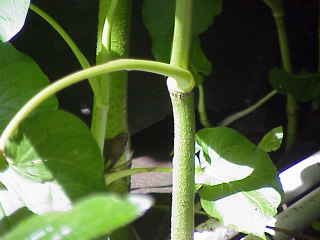
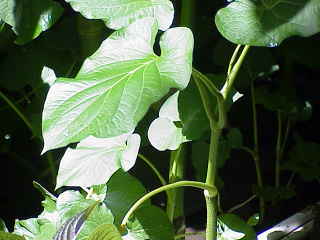
Comments received are recorded below. Please let me know if you want your comments removed, edited, or credited differently!
15 January 2000
I am guessing but it looks like it might be Piper wichmannii. Because of the
suckering Dave Lorence suggests it could be Piper auritum (I tend to believe
him). Dave says to crush the leaves and check for a "ben-gay" type
of aroma. That odour would suggest P. auritum.
Piper auritum (possibly also known as P. sanctum) has a dense row of
white hairs on the margin of the leaf that are visible without a handlens, also our plants
here have a reddish tinge to the petioles. Hopefully this will
be of some help.
Tim Flynn
==============
Perhaps Piper auritum. Produces large stands through suckering here in Miami. Central America to Colombia, especially Mexico. RHS Index describes it: 4.5 M; aromatic, Lvs 25x16cm, ovate to elliptic/ovate, base cordate, acuminate apex, thinly pubesc. above, densely underside. petiole winged. Spikes 18cm.
Best, Kirsten Llamas
[Fairchild Tropical Garden]
==============
19 January 2000
Dear Konrad, Bill and Dana --
Dana sent me the photos of the plant and I passed them on to several botanists. The most positive identification I got was from David Lorence of the National Tropical Botanical Garden, who says he thinks it is Piper auritum Kunth (Piperaceae), which correlates with your information. He says it suckers prolifically and has a characteristic odor like "Ben-gay". Looking on the internet, I found that it is native of Mexico and Central America, and is an invasive species in Florida. Common names are eared pepper and hoja santa. No word as to whether or not it is poisonous, but it is cited as a herbal medicine for wounds. I also found a nice photo of it at the Missouri Tropical Botanical Garden site, which I'm attaching. If you can compare the plant to the photo you can probably be pretty sure that it is the same plant, but the next time someone goes to Guam I would send a specimen (both leaves and flowers) to Lynn Raulerson at the U. of Guam--she's the closest professional botanist that I know of. Of course, when we come to Pohnpei we will collect specimens, too, but you probably want to get started before then.
[Attached photo was from Missouri Botanic Garden Piper auritum Kunth TROPICOS database.]
For other information on this plant, please now see:
http://www.hear.org/pier/piaur.htm
http://www.hear.org/pier/acaur.htm
James C. Space
Pacific Island Ecosystems at Risk (PIER)
11007 E. Regal Dr.
Sun Lakes, AZ 85248-7919
http://www.hear.org/pier
======
Dear Jim:
Your message re. Piper auritum is interesting Jim. After receiving it I looked up P. auritum on the GRIN world economic plants database http://www.ars-grin.gov/npgs/tax/taxecon.html. They give it the common names of cordoncillo, anisillo and Santa Maria, and say that it is cultivated in Cuba as a food additive or flavouring.
Barbara Waterhouse
=======
Dear Jackson,
Dr. Raulerson from the UNG agrees that the plant is Piper auritum. She also recommends an eradication program. As we discussed in our Friday's meeting there should be no reason why we should not start with the eradication program. We should get this week a radio program and if possible something on TV with Bermin. We must not lose time.
Regards, Konrad Englberger
Plant Protection Micronesia
==========
[Konrad:]
Thank you so much; the specimens were well-dried and in good condition. I appreciate your work. I tend to agree with your Hawai'i botanist - the species name he gave; I also agree that you had better move those that are already there OUT of Pohnpei; this species seems to be able to be very invasive, and you don't need that on an island like Pohnpei! I will send a sample to the Smithsonian for their input.
Lynn Raulerson
==========
10 February 2000
I like to update you on the false Kava eradication work in Pohnpei.
I received a reply from Dr. Lynn Raulerson from the University of Guam stating that she agrees with the earlier identification from the National Tropical Botanical Garden in Hawaii, where the photos have been identified as Piper auritum. Dr.Raulerson has sent specimens to the Smithsonian Institute for further identification.
Meanwhile, a survey was conducted to find out about the spread of the plant, Alert posters have been printed/distributed
and testing of herbicides has started. More public awareness activities e.g. Television will follow next week.
Most of our committee members are convinced that this plant is an invasive weed and it could jeopardize the sakau industry. However there are some extension agents who are not convinced of its negative effects and do not fully agree that this plant be eradicated.
According to the literature P. auritum is used in authentic Mexican cooking, leaf serves as tamales, roots have been used to treat snake bites and facilitate bleeding, and as a beverage much like Kava.
In today's committee meeting we decided to collect and destroy plants from people who volunteer. However there are some people who have plants and are not willing to give up their plants. We may have to go through the Attorney's Office to get an emergency state order to enter into owners' properties to destroy their plants.
Before we take any legal action, I would like to ask you all for your opinion about the usefulness of this plant.
I know from communications with Dr.Raulerson, Jim Space and others that we should eradicate this plant.
Our committee will be very thankful to your comments.
Best regards,
Konrad Englberger
Plant Protection Micronesia
=============
10 February 2000
I feel we need the support and assistance of the traditional leadership here on Pohnpei in the eradication campaign. Piper auritum is a direct threat to Piper methysticum, a plant that is central to so many of the traditions and cultural practices of Pohnpei. Court ordered removal might meet opposition. Orders to remove made by the traditional leadership are more likely to receive broad based support. Regardless of whether the plant has uses elsewhere, this is a dangerous, invasive, alien plant here on Pohnpei. P. auritum can outgrow and outcompete P. methysticum. P. auritum does not belong here and must be removed.
- Dana Lee Ling's two cents
=============
10 Febrary 2000
That this species is considered a pest in southern Florida is not a good omen for Pohnpei. It apparently has several characteristics that make it a good invader: production of numerous small seeds probably spread by birds and maybe bats and the ability to sucker profusely, which gives it the advantage of spreading vegetatively and makes it difficult to remove.
I am glad to see that you're going to at least consider eradiction rather than de facto letting it become one of the numerous invasive species impacting Pohnpei. Some things to consider in your evaluation include (off the top of my head):
Well, maybe that's enough for now--others can probably add things I've forgotten. I don't want to discourage you or slow you down too much because time is of the essence with a new species such as this, but a little analysis and planning up front (combined with public communication) can save a lot of trouble later on.
Another thought--it might be well to bring in someone who is familiar with the species and how to deal with it to help you with the evaluation and planning (from Florida, for instance). If the species is impacting or likely to impact forested ecosystems, the Forest Service might be able to provide assistance in this regard (helping to find such a person and assisting in sending them to Pohnpei). If it's more of an agricultural pest, maybe NRCS could help, Phil. It would also be a good strategy to do this if you plan to request any U.S. Federal cost-share funds.
Like I say, I'm very happy to see your proactive approach. Let me know of areas where I can be of assistance.
For other information on this plant, please see:
http://www.hear.org/pier/piaur.htm
http://www.hear.org/pier/acaur.htm
James C. Space
Pacific Island Ecosystems at Risk (PIER)
11007 E. Regal Dr.
Sun Lakes, AZ 85248-7919
http://www.hear.org/pier
=============
Alert released by the false sakau committee:
A new weed which belongs to the same family as Sakau (Kava or Piper methysticum) has been found in the U District of Pohnpei, and is believed to be spreading to other areas in Pohnpei by people.
This plant is a false sakau and does not contain any kavalactones – the chemicals that give Pohnpei’s sakau it’s popular effect! It’s presence on Pohnpei jeopardizes traditional sakau production and consumption and also a potential sakau export market. The plant grows very fast, is hard to kill, and competes with our other useful plants. This plant has no useful characteristics!!!
The plant can grow up to 18 feet high; Large light green leaves 7 to 20 inches; The leaves have a characteristic anise-like odor.
If you have this plant on your land or in your community, kill/eradicate it!
False Kava plants can be destroyed by up-rooting the plant and burning it, or by use of
chemical herbicides.
Phone: 320-7457 Agriculture
Phone: 320 7523 SPC Plant Protection
Phone: 320-5731 COM Land Grant
Phone: 320 4267 Nature Conservancy
=============
13 February 2000
Clarifications and people who need to be credited from Konrad Englberger:
We have an excellent task force committee and I feel that members of the committee should have been mentioned. We all have to justify our time for our activities to our organizations and departments.
There is Adelino Lorens, Deputy Chief, Office of Agriculture & Forestry who reported the false Sakau first and made good contacts with the people in U Municipality.
Then there is myself, from the Plant Protection Project of the Secretariat of the Pacific Community, which is an Aus AID funded project. I was one of the main players responsible for getting the false Sakau task force started.
Jackson Phillip from COM (FSM) Land Grant, who is also the Chair person from the committee, was the one who took the photos and I have sent them to various people for identification. The first identification was done from Jackson Phillip's images at the Tropical Botanical Garden in Hawaii, and not from yours.
Jackson Phillip and myself, with the help of the committee, produced posters for public awareness.
It is also planned to produce an awareness video with BNN.
Bill Rayner and Mark, from the Nature Conservancy, collected leaves and flowers for preservation, and I sent them to the botanist, Dr. Lynn Raulenson, for identification.
Phil Gils and Gibson Santos from the USDA Natural Resources Conservation Service have started research work using herbicides to determine the best method to destroy this plant.
Field surveys were carried out to determine the extent and distribution of the false Sakau.
On Friday 11 February, the first false Sakau plants were collected by Gils, Santos, Mark and myself in the Village of Yosamaru, U Municipality.
There is some other information which you did not get right in your press release. The committee has a very good idea who brought the plant to FSM, however we do not want to start pointing fingers; we should be more concerned to get the plant eradicated from the island and we expect support and cooperation from everyone.
Another very important fact was missing in you press release and this is how the plant spreads. It is not only spread by humans: birds and fruit bats like to feed on the seed and can spread it all over the country.
Regards
Konrad Englberger
Plant Protection Micronesia
===========
On the 9th of May 2000 the Institute of Applied Sciences, USP ran an analysis of a sample of P. auritum from Pohnpei. The Institute received the sample on 27 April 2000. Support for this analysis came from Konrad Englberger and Dan Perin along with the False Sakau task force. The results were as follows:
| Client ID | False Kava |
|---|---|
| Lab. No. | 2000/883 |
| Desmethoxy yangonin | Not detected |
| Dihydrokavain | Not detected |
| Yangonin | Not detected |
| Kavain | Not detected |
| Dihydromethysticin | Not detected |
| Methysticin | Not detected |
| Total lactones g/100g | Not detected |
Extraction of lactones using organic solvents followed by HPLC determination. None out of six kava lactones were detected. The limits of reporting for individual kava lactones are 0.1 g/100 g. Signed by a P. Ravi on the 5th of May 2000.
To the other credits on this page I would add that the National Tropical Botanic Garden has been assisting this effort as well:
David H. Lorence
National Tropical Botanical Garden
3530 Papalina Road
Kalaheo, Kauai, HI 96741
tel (808) 332-7324 ext. 123
fax (808) 332-9765
Please, if I have anything wrong or need to include other credits, let me know!